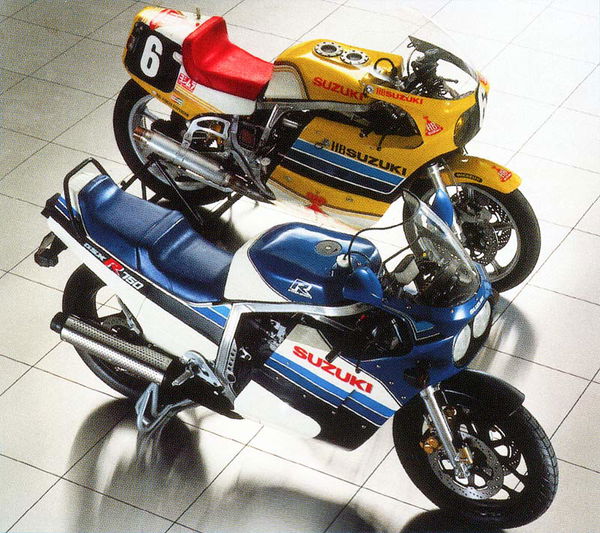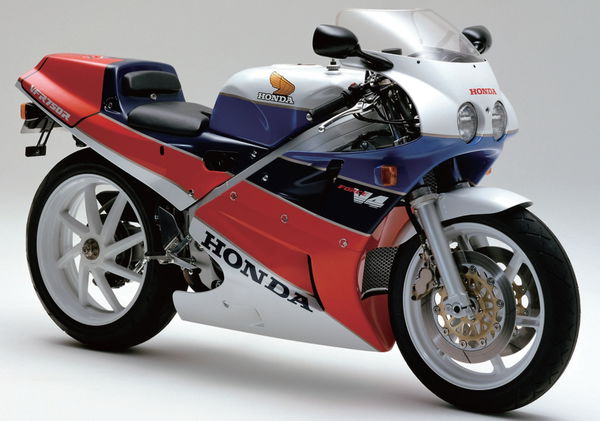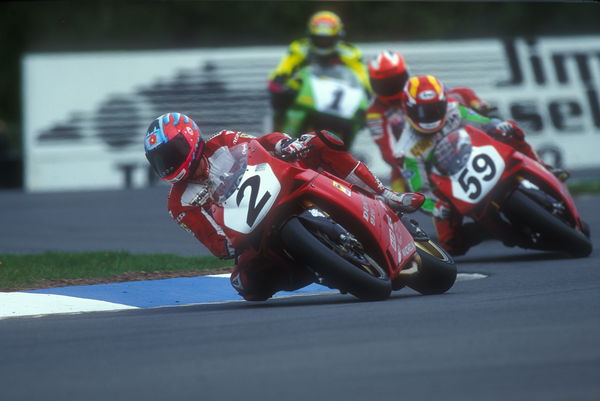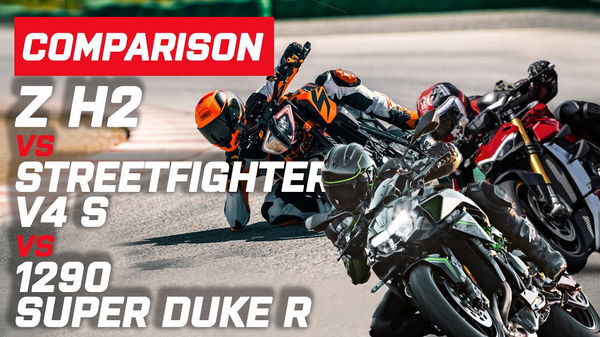35 years of Gixxer: How the Suzuki GSX-R750 spawned a golden era of Superbike
How the trailblazing Suzuki GSX-R750 marked the start of a decade of advances and successes that transformed the sportsbikes

With 2020 marking the 35th anniversary of the launch of the original 1985 GSX-R750, it’s worth remembering that the landmark Suzuki is far more significant than merely being the first of a Gixxer dynasty – it was also a major catalyst for a whole new class: the racer replica superbike.
As one journalist wrote in 1985 shortly after testing it: “Sportsbikes will soon be divided into two categories; before the GSX-R and after.” Turns out he was absolutely spot on.
Up to 1985, although significant strides had been made towards what we today consider the modern superbike, most notably with Kawasaki’s 1983 GPz900R, lightweight, aluminium-framed, high-revving, race-fairing-ed 750cc+ machines remained the preserve of the race track, particularly in F1 and endurance.
After the GSX-R, however, that recipe, helped admittedly by other factors, became the norm and over the next decade would spawn a golden generation of machines, many of which are today considered modern classics.
In short, without the first GSX-R750, iconic sports bikes which shaped much of our youth such as the Kawasaki ZXR750, Honda Fireblade, Yamaha YZF750 and more, which all, to a greater or lesser degree, followed the GSX-R750’s ‘racer recipe’, might never have happened…

Suzuki GSX-R750 ushers in a new era for performance
The story of the creation of the GSX-R has been told many times before. In a nutshell it’s one of how Suzuki, sensing the need for quantum change in a time of huge competition between rival Japanese manufacturers, focused on lighter weight, took inspiration from its 1983 Suzuka 8-hour winning XR41 endurance racer (the first with a box-section aluminium, double cradle frame) and married it to a high-revving, powerful, new 16-valve transverse four (itself made compact and light by the crafty adoption of oil cooling) to create the first GSX-R750F.
What’s less well known is that, although a sensation, the 100bhp GSX-R was actually (and, with hindsight, perhaps understandably) more of a success on track than on the street. At the time, Yamaha’s also new-for-1985 five-valve but steel-framed FZ750 was widely considered the better roadster.
While Honda’s CBX750, produced largely as a ‘stop-gap’ between Honda’s flawed VF750F and the brilliant VFR750F V4s, featured ‘old tech’ air-cooling and a tubular steel twin loop frame yet still sold well.
But for racers – and particularly privateers – the GSX-R was the new king. In the UK’s Superstock championship, the Gixxer was the ‘go-to’ choice; in world endurance, the Suzuki was virtually race-ready straight from the crate, and in the US, where points-scoring AMA privateers were bonused by Suzuki USA, the GSX-R wasn’t just race-competitive, it was financially lucrative, too.
This superbike ‘sea change’ was reaffirmed the following year, in 1986, when Suzuki followed up the GSX-R750 with a bigger variant, the first 125bhp GSX-R1100G.

Yamaha joins the part with the FZR1000 Genesis
Then, in 1987, this new superbike credo of lightweight achieved via aluminium frames with racer replica styling was confirmed once and for all when Yamaha launched its own version, the FZR1000 Genesis.
That bike was developed out of a bigger version of Yamaha’s five-valve FZ750 motor but this time held in a larger variant of the twin-spar aluminium ‘Deltabox’ frame Yamaha had debuted in the previous year’s FZR400.
The Genesis’s success, combining 135bhp with previously unforeseen litre-bike handling, set the new benchmark for superbike performance – particularly when succeeded by an EXUP exhaust-valve equipped, 145bhp version in 1989 (often simply known as the ‘EXUP’) – for the next five years. It was the start of a new era. That ‘Genesis’ name had been well chosen, after all.
But if all that sounds like the end of the transition from old school machines to modern racer-replica superbikes, it was actually just the start.

Honda, Kawasaki make Japan the superbike superpower
Honda entered the fray, in typical no-holds-barred fashion, by producing the ‘ultimate production racer’, the sublime VFR750R ‘RC30’ in 1988. And while this £10K jewel was out of reach for most, remaining little more than a poster bike, it did have a massive influence on superbike development and confirmed the marketing value of the production racer.
Besides, the parallel popularity in the late ‘80s and early ‘90s of more affordable, often grey import, 400cc ‘mini superbikes’ such as the RC’s little brother, the NC30, helped further popularise race-replica superbikes by grooming a new generation towards the breed…
Kawasaki first got in on the act in 1989 with its ZXR750H1 – but ‘Special K’ did it in such a way as to further enhance and make accessible this new type of bike. Although, as with the RC30, the ZXR was spawned from endurance racing, in this case the visually virtually identical works ZX7-R racer (which in turn was based around a tuned GPX750 motor held in a by then universal aluminium perimeter or twin spar frame) that was where the similarities ended.
Instead, while Honda RC30’s was an exclusive, expensive production version of the racing RVF, Kawasaki’s production ZXR, although looking like a ZX7-R, was actually little more than a reframed, restyled GPX, almost half the RC’s price as a result and quickly became a cult racer for the man in the street. Besides, if you wanted an exotic, expensive racing version, Kawasaki soon had that covered, too, by producing limited edition ‘R’ versions, which proved more than capable of winning in BSB and world endurance…

Win on Sunday, buy on Monday
All of that, combined with the launch and rapid success of the World Superbike championship in 1988 meant that, by 1990, race-styled superbikes, whether in 750 (GSX-R7, ZXR) or 1000cc (FZR, GSX-R11) forms were utterly dominant as larger capacity motorcycles, would remain so for much of the decade and yet were all triggered, arguably, by the original 1985 GSX-R750.
But the best was still to come. In 1992, Honda, again being Honda, threw that 750/1000cc distinction out by launching its revolutionary Fireblade, a bike which followed the original GSX-R’s mantra of lightweight to the nth degree by being an 893cc, 122bhp litre bike but with the 185kg dry weight and dinky proportions of a 600. It was a bike which truly rewrote the rules.
The only irony is that, by doing exactly that, it wasn’t eligible for either WSB or world endurance so never achieved race success, and also was never a racer it could be a replica of – at least, not until after 2003 when the WSB rules changed. Perhaps it didn’t matter: the original Blade remains an icon which, again, may never have happened had it not been for that first GSX-R…

Ducati fires one back for Europe with the 916
But one manufacturer that definitely DID profit from the new ultralight/1000cc superbike mantra was Ducati. The Italian firm’s 1000cc V-twins did adhere to WSB’s 750cc fours or 1000cc V-twins formula and its 851/888 desmos had dominated between 1990 and 1992. But more was about to come.
The succeeding 916 of 1994 with its striking svelte lines and booming V-twin might not have been a direct descendant of the GSX-R but would surely never have come into being without the new style superbikes it had inspired.
Sadly for the GSX-R, ZXR and more, the 916’s dominance, in winning six of the next nine WSB championships, primarily in the hands of Brit Carl Fogarty, effectively brought this first golden era of race replica superbikes to an end.
The latest and arguably best of the Japanese 750s, Yamaha’s YZF750 as introduced in 1993, although a winner in BSB and at Daytona and a brilliant bike in its own right, never really got the better of the Ducati. Nor did Honda with its exorbitant RC45 in 1994 or even Suzuki with its all-new, beam-framed GSX-R750, the ‘SRAD’, in 1996.
Instead, unable to compete with their 750s, another era then began when Yamaha unveiled its FireBlade-beating R1 in 1998. Though brilliant, it wasn’t a race-replica, yet it was so good others, most notably Suzuki with its 2001 GSX-R1000, were forced to soon follow.
By then the once ground-breaking 750s were virtually forgotten and, from 2003, the new 1000s took over in WSB. That, however, is another story.
Those brilliant 750s meanwhile, as all started with that first GSX-R, are now considered the classics they always deserved to be.











